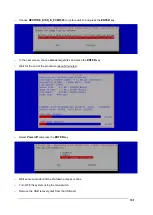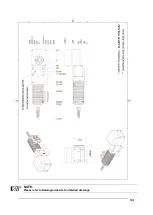
96
RADIATION VIEWING CONDITIONS
The Laser output by the resonator is to be considered as a highly collimated and intense monochromatic
light source. Due to these characteristics it can be seen as a “point source” of high luminosity. This means
that its image is then focalized on the Retina in a very small spot with a dangerously high power density! If
the beam becomes divergent and scatters to a non-
reflecting screen, then there is an “extended vision” of
the image, with a decisively less dangerous power density. So there are different types of radiation viewing
based on the access to the radiation and consequently different degrees of dangerousness.
DIRECT VIEWING OF THE LASER BEAM
This type of viewing is the most dangerous and can occur at the outlet of the laser aperture after having
removed the lens. It is to be avoided at all costs! No protective goggles represent a valid means against
direct viewing of the beam.
DIRECT VIEWING OF THE BEAM AFTER MIRROR REFLECTION
This may occur by directing the beam on a reflecting surface.
Viewing of a mirror reflected beam from a flat surface is very dangerous and equal to direct viewing.
DIRECT VIEWING OF THE BEAM OUTPUT BY AN OPTICAL FIBER
This happens if an Optical Fiber disconnects from the resonator. Viewing of the beam is dangerous up to a
significant distance. Filters and Goggles do not ensure safety.
DIRECT VIEWING OF THE BEAM AFTER FOCUSING
This occurs if the laser beam is not extinguished with an opportune absorber at the end of its useful path.
Looking at the beam is dangerous up to a considerable distance. Filters and goggles can ensure safety for
brief exposure, as long as they are the right size and certified.
SCATTERED VIEWING OF THE BEAM AFTER FOCUSING
This is the most frequent viewing, but opportune Filters and Goggles can ensure safety, even for prolonged
exposure.
The Nominal Ocular Hazard Distance (N.O.H.D.) for
Vlase
™ are shown in the next paragraph.
WARNING!
Always use goggles with conformity certificate.
Remember that
no goggles can provide prolonged protection from direct or mirror-reflected
radiation!
Summary of Contents for VLASE IR 1PWX-TLS2
Page 1: ...USER S MANUAL VLASETM IR ...
Page 34: ...VLASETM IR 34 2 2 6 CONNECTION EXAMPLES Figure 27 Connection examples ...
Page 85: ...85 EXTERNAL LABEL PLACING Figure 67 Positioning of external labels rack ...
Page 86: ...86 Figure 68 Positioning of external labels resonator ...
Page 90: ...90 BLOCK DIAGRAM VLASETM SAFETY LOGIC DETAILS FOR AUTOMATIC PRODUCTION LINE ...
Page 108: ...108 APPENDIX G MECHANICAL DRAWINGS ...
Page 109: ...109 NOTE Please refer to Datalogic website for detailed drawings ...
Page 112: ......
















































